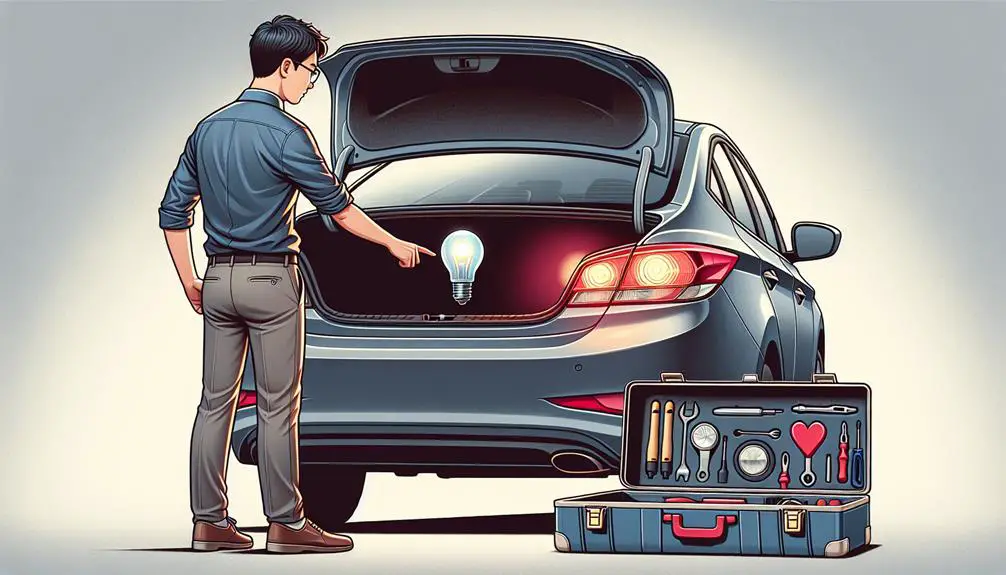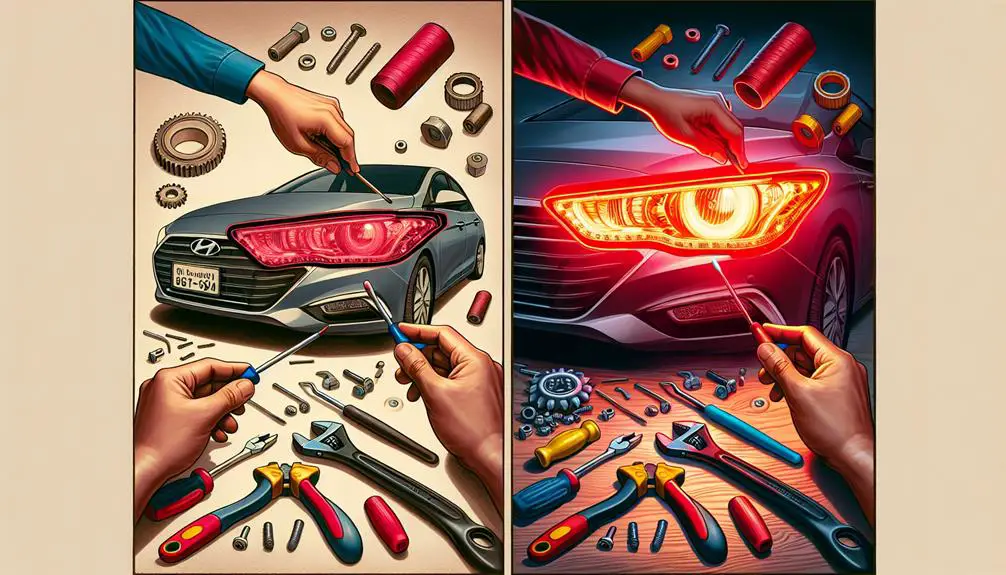Changing your 2016 Hyundai Elantra's brake light involves a few steps. First, you need to remove the tail light assembly to access the bulb. Once the assembly is removed, you can replace the bulb with a new one. Finally, reassemble the tail light assembly back onto your car.
Remember to test the new brake light to ensure it is functioning properly before completing the job.
Identifying the Issue

Essential, it's vital to determine if your Hyundai Elantra's brake light issue is because of a burned-out bulb, a fuse problem, or a more complex electrical issue. You're not just fixing a light; you're ensuring your safety and that of other drivers. Let's investigate and figure out what's going on with your brake lights.
Initially, check if all the brake lights aren't working or if it's just one. If all the lights are out, it's likely a fuse issue rather than individual bulbs. Your Elantra's manual will show you where to find the fuse box and which fuse controls the brake lights. If the fuse looks blown, replacing it might solve your problem.
However, if it's just one light that's out, the culprit is probably a burned-out bulb. Brake light bulbs can go at any time, and it's not uncommon for them to need replacement during the life of your vehicle.
On the other hand, if the fuse and bulbs seem fine, you might be looking at a more complex electrical issue. This could involve the brake light switch, wiring, or a connection problem. These issues are trickier and might require a professional's touch.
Gathering Necessary Tools
Now that you've pinpointed the issue with your brake lights, it's time to gather the necessary tools for the job.
To start off, you'll need a Phillips head screwdriver. This is important for removing the screws that hold the tail light assembly in place. Make sure you've got one that's the right size to avoid stripping the screws. You won't be needing this for the next step of removing the tail light assembly, but it's critical for the initial stages.
Next, grab a pair of gloves. Changing a brake light isn't the dirtiest job, but you'll want to keep your hands clean and free from any sharp edges inside the trunk area. Plus, handling the new bulb with gloves prevents the oils from your skin from shortening its lifespan.
You'll also need a replacement brake light bulb. Make sure you've got the correct type for your 2016 Hyundai Elantra. The owner's manual or a quick online search will tell you exactly what bulb model you need. It's typically a good idea to buy a pair, even if you're only replacing one. That way, you have a spare for next time, and your brake lights will wear evenly.
Finally, have a small flashlight handy. Even in daylight, the corners of your trunk can be dim, making it tricky to see what you're doing. A flashlight will help you avoid any guesswork.
Gathering these tools beforehand ensures a smooth and efficient replacement process, saving you time and frustration.
Removing the Tail Light Assembly

To remove the tail light assembly on your Hyundai Elantra, start by opening the trunk to access the back of the light panel. You'll need to peel back the trunk's lining or carpeting to reveal the tail light assembly's mounting points. In most cases, this simply involves pulling away a section of the trunk's interior lining, but be gentle to avoid tearing or damaging it.
Next, you'll spot several nuts or bolts securing the tail light assembly to the vehicle's body. These are usually 8mm or 10mm in size, so make sure you've got the right socket from the tools you gathered earlier. Using a socket wrench, carefully loosen and remove these nuts or bolts. Keep them in a safe place as you'll need them to secure the tail light assembly back once you're done.
Once the fasteners are removed, gently push the tail light assembly towards the outside of the car to disengage it from its mounting bracket. This step might require a bit of wiggling to free the assembly, especially if it's never been removed before. Be cautious not to use excessive force to avoid cracking the plastic.
With the tail light assembly now detached, you'll notice it's still connected to the vehicle by a wiring harness. Locate the connector, which is usually at the back of the assembly, and disconnect it by pressing down on the tab and pulling it apart. Now, you've successfully removed the tail light assembly from your Hyundai Elantra, giving you access to the brake light and other bulbs housed within.
Replacing the Brake Light Bulb
With the tail light assembly removed, you're ready to replace the brake light bulb in your Hyundai Elantra. First, you'll need to locate the faulty brake light bulb. It's typically easy to spot once the assembly is off. You'll see a few bulbs, but you're looking for the one that's usually red and located in a position that matches where your brake light is on the outside.
Before you touch the new bulb, make sure your hands are clean or use a clean cloth to handle it. Oils from your skin can shorten the life of the bulb. Gently twist the old bulb counter-clockwise to remove it from the socket. Then, carefully insert the new bulb into the socket and twist it clockwise until it's secure. Avoid over-tightening to prevent damage.
Here's a quick guide to help you understand the process better:
| Step | Action | Tip |
|---|---|---|
| 1 | Locate the brake light bulb socket | It's typically red |
| 2 | Remove the old bulb | Twist counter-clockwise |
| 3 | Handle the new bulb with care | Use a clean cloth |
| 4 | Install the new bulb | Twist clockwise, don't over-tighten |
Reassembling and Testing

After replacing the brake light bulb in your Hyundai Elantra, it's time to reassemble the tail light assembly and test the new bulb to guarantee it's working properly. The process is straightforward, but it's important to follow each step carefully to make sure everything is secure and functioning as it should.
Here's how to reassemble and test your brake light:
- Reattach the Tail Light Assembly
- Carefully align the tail light assembly back into its original position on your Elantra. Make sure the clips or screws that hold the assembly in place are aligned correctly. Once everything is lined up, push the assembly back into place until it clicks or secure it with the screws, depending on your model. This step is important for ensuring the light is properly positioned and sealed against the vehicle, preventing any moisture from entering.
- Reconnect the Battery (if disconnected)
- If you disconnected the battery for safety while replacing the bulb, now's the time to reconnect it. Ensure the terminal connections are clean and tighten the battery clamps securely. This step is necessary for restoring power to your vehicle's electrical system, including the brake lights.
- Test the Brake Light
- It's time to test the new bulb. Turn on your Elantra's ignition and press the brake pedal, or have someone else do it while you check the light. You should see the new brake light shining brightly. If it doesn't light up, double-check your connections and make sure the bulb is properly installed.
Conclusion
You've successfully navigated through identifying the issue with your 2016 Hyundai Elantra's brake light, gathered all necessary tools, removed the tail light assembly, and replaced the faulty brake light bulb.
Now, after reassembling everything and testing to make sure it's working perfectly, you're all set. Your brake lights should now be shining brightly, enhancing your safety on the road.
Remember, maintaining your car's lighting is essential for your visibility and to communicate effectively with other drivers.
Well done!